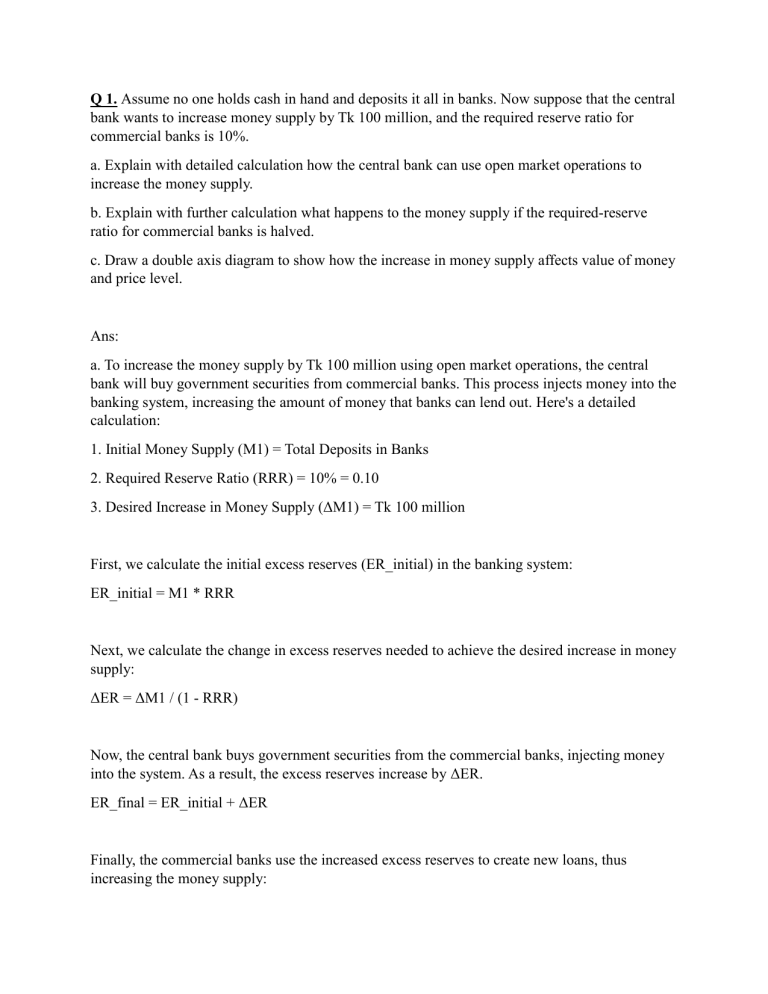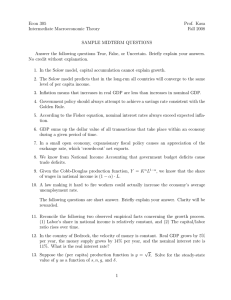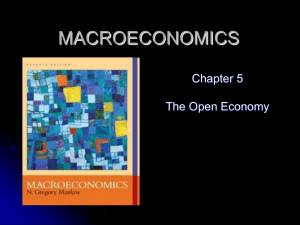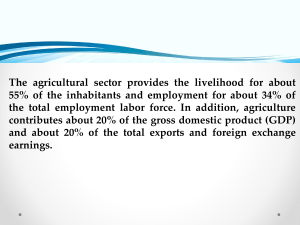
Q 1. Assume no one holds cash in hand and deposits it all in banks. Now suppose that the central bank wants to increase money supply by Tk 100 million, and the required reserve ratio for commercial banks is 10%. a. Explain with detailed calculation how the central bank can use open market operations to increase the money supply. b. Explain with further calculation what happens to the money supply if the required-reserve ratio for commercial banks is halved. c. Draw a double axis diagram to show how the increase in money supply affects value of money and price level. Ans: a. To increase the money supply by Tk 100 million using open market operations, the central bank will buy government securities from commercial banks. This process injects money into the banking system, increasing the amount of money that banks can lend out. Here's a detailed calculation: 1. Initial Money Supply (M1) = Total Deposits in Banks 2. Required Reserve Ratio (RRR) = 10% = 0.10 3. Desired Increase in Money Supply (ΔM1) = Tk 100 million First, we calculate the initial excess reserves (ER_initial) in the banking system: ER_initial = M1 * RRR Next, we calculate the change in excess reserves needed to achieve the desired increase in money supply: ΔER = ΔM1 / (1 - RRR) Now, the central bank buys government securities from the commercial banks, injecting money into the system. As a result, the excess reserves increase by ΔER. ER_final = ER_initial + ΔER Finally, the commercial banks use the increased excess reserves to create new loans, thus increasing the money supply: ΔM1_actual = ER_final / RRR b. If the required reserve ratio (RRR) for commercial banks is halved (i.e., reduced to 5%), the impact on the money supply can be calculated as follows: 1. New Required Reserve Ratio (New RRR) = 5% = 0.05 Using the formula for calculating the change in excess reserves needed to achieve the desired increase in money supply: ΔER_new = ΔM1 / (1 - New RRR) The new excess reserves (ER_new) can be calculated as: ER_new = ER_initial + ΔER_new And the actual increase in the money supply (ΔM1_actual_new) would be: ΔM1_actual_new = ER_new / New RRR c. In a double-axis diagram, we can show the relationship between the increase in money supply and its effect on the value of money and the price level. The x-axis represents the money supply, and the y-axis represents the value of money and the price level. ``` Value of Money ^ | A | /| | / | | / | / | / | / | | / / | | | | | | | / | |/ | +-----------------------+---> Money Supply B | | | | | | | +---> Price Level ``` In the diagram: - The line segment AB represents the relationship between the increase in money supply and the value of money. As the money supply increases (moving along the x-axis from A to B), the value of money decreases. This means that each unit of money is worth less, indicating higher prices. - The line segment BC represents the relationship between the increase in money supply and the price level. As the money supply increases (moving along the x-axis from B to C), the price level also increases. This is due to the quantity theory of money, which suggests that an increase in the money supply leads to proportional increases in prices. Overall, the diagram illustrates how an increase in the money supply affects both the value of money and the price level. Q 2: Suppose the nominal GDP in an economy is TK 2 billion and the velocity of money is 10. Using the quantity theory of money show (with calculations): a. What is the money supply in this economy? b. Now if the money supply doubles and the velocity is constant show what happens to the nominal GDP. c. With velocity remaining constant and real output equal to 10,000 units, what is the price level? Ans: The Quantity Theory of Money states that the product of the money supply (M), velocity of money (V), and the price level (P) is equal to the nominal GDP (Y), i.e., M * V = P * Y. Using this equation, let's calculate the answers to your questions: a. Money Supply (M) = (Nominal GDP) / (Velocity of Money) M = TK 2 billion / 10 M = TK 200 million b. Doubling Money Supply: Let's calculate the new nominal GDP (Y_new) when the money supply (M) doubles while the velocity (V) remains constant. New Money Supply (M_new) = 2 * TK 200 million = TK 400 million Y_new = (M_new) * V = TK 400 million * 10 = TK 4 billion The nominal GDP increases to TK 4 billion. c. Calculating Price Level (P) with Constant Velocity and Real Output: We know that M * V = P * Y Given: Velocity (V) = 10 Real Output (Y) = 10,000 units Money Supply (M) = TK 200 million (as calculated in part a) Rearranging the equation to solve for the price level (P): P = (M * V) / Y P = (TK 200 million * 10) / 10,000 = TK 2000 The price level is TK 2000. To summarize: a. Money Supply (M) = TK 200 million b. New Nominal GDP (Y_new) = TK 4 billion c. Price Level (P) = TK 2000 Q3: With the help of a diagram show and explain what happens to Aggregate Demand (AD) and Aggregate Supply (AS) in the event of a war between US (biggest importer of Bangladeshi garments) and the Middle East (major exporter of crude oil to Bangladesh). Explain what measures the government can take to deal with unemployment. Ans: In the event of a war between the US and the Middle East, which are significant trading partners for Bangladesh, there would be notable effects on the Aggregate Demand (AD) and Aggregate Supply (AS) in the economy. Let's break down the changes and illustrate them with a diagram: Aggregate Demand (AD): AD represents the total demand for goods and services in an economy. It is composed of consumption, investment, government spending, and net exports (exports - imports). Impact on Consumption: During times of uncertainty and war, consumer confidence tends to decrease. People may become more cautious about their spending due to fears about the economy and job security. This leads to a decrease in consumption. Impact on Investment: Similarly, businesses may postpone or reduce their investment plans as they anticipate lower demand and economic instability. Impact on Net Exports: If the US (a major importer of Bangladeshi garments) is involved in the war, its demand for imports could decrease, negatively affecting Bangladesh's exports. Additionally, if there is disruption in oil supply from the Middle East, it could lead to higher oil prices, affecting the cost of production and potentially reducing exports. As a result, the AD curve shifts to the left, indicating a decrease in overall demand in the economy. Aggregate Supply (AS): AS represents the total supply of goods and services in the economy. It is influenced by factors such as input prices, technology, and productivity. Impact on Input Prices: If the war disrupts oil supply from the Middle East, oil prices could increase significantly. This would raise production costs for many industries, including the garment industry in Bangladesh. Impact on Production and Supply Chains: The war could disrupt global supply chains, leading to shortages of key inputs and components, further affecting production and supply. As a result, the AS curve shifts to the left, indicating a decrease in overall supply in the economy. Now, let's represent these changes in a diagram: ``` Price Level ^ | | AD_initial | | /\ / \ AD_final | / \ |/ \ +--------------------------> Real GDP AS_initial /\ / \ / / \ AS_final \ +--------------> Real GDP ``` - The initial equilibrium is at point E, where AD_initial intersects AS_initial. This represents the initial level of Real GDP and Price Level. - Due to the war's effects on consumption, investment, net exports, input prices, and supply chains, both AD and AS curves shift to the left. The new equilibrium is at point E', with lower Real GDP and potentially higher Price Level. To deal with unemployment resulting from this scenario, the government can take measures to stimulate economic activity and boost employment: 1. **Fiscal Policy:** Increase government spending on public projects and infrastructure to create jobs and stimulate demand. 2. **Monetary Policy:** The central bank can lower interest rates to encourage borrowing and investment by businesses. This can help stimulate economic activity. 3. **Export Diversification:** Encourage diversification of exports to reduce dependency on a single trading partner. This can mitigate the impact of reduced demand from any specific country. 4. **Support to Industries:** Provide financial assistance or subsidies to industries affected by disruptions in supply chains or input costs. This can help them maintain production and employment. 5. **Training and Skill Development:** Invest in training and skill development programs to help workers transition to industries less affected by the war's impact. 6. **Social Safety Nets:** Strengthen social safety nets to provide support to individuals who may lose jobs or face reduced income. These measures can help mitigate the negative effects of the war on unemployment and support economic recovery. Q4: With 100Tk Adam can buy 1$ and suppose that sugar sells for $5/kg in the Australia and in Bangladesh it sells for Tk 160/kg a. What is the real exchange rate? b. Now suppose that 1$ exchanges for Tk 80, explain its impact on the real exchange rate and Bangladesh’s net exports. Ans: a. The real exchange rate (RER) is the ratio of the price levels of two countries' goods in terms of each other's currency. It helps determine the relative competitiveness of goods in different countries. Real Exchange Rate (RER) formula: RER = (Nominal Exchange Rate * Domestic Price Level) / Foreign Price Level Given: Nominal Exchange Rate (Tk/$) = 100 Domestic Price Level (Tk/kg) = Tk 160/kg (sugar in Bangladesh) Foreign Price Level ($/kg) = $5/kg (sugar in Australia) RER = (100 * 160) / 5 RER = 3200 / 5 RER = 640 So, the real exchange rate is 640. b. If the nominal exchange rate changes to 1$ = Tk 80, it means that the Bangladeshi Taka (Tk) has appreciated in value against the US Dollar ($). Let's analyze the impact on the real exchange rate and Bangladesh's net exports: 1. **Impact on Real Exchange Rate (RER):** The new RER can be calculated using the same formula as before, but with the new nominal exchange rate: RER_new = (Nominal Exchange Rate * Domestic Price Level) / Foreign Price Level RER_new = (80 * 160) / 5 RER_new = 12800 / 5 RER_new = 2560 The new real exchange rate is 2560. 2. **Impact on Net Exports:** An appreciation of the domestic currency (Tk) means that the goods produced in Bangladesh become relatively more expensive for foreign buyers, while foreign goods become relatively cheaper for Bangladeshi consumers. This can have the following effects: - **Exports:** Bangladeshi exports might become more expensive for foreign buyers due to the stronger Tk. This could lead to a decrease in the quantity of exports, which may negatively impact net exports. - **Imports:** Foreign goods become cheaper for Bangladeshi consumers, potentially leading to an increase in imports. Overall, the change in the nominal exchange rate can affect the balance of trade and potentially lead to a decrease in net exports, depending on the relative responsiveness of import and export quantities to changes in price (exchange rate). It's important to note that changes in the nominal exchange rate can have complex effects on a country's economy and its trade relationships. Other factors, such as demand for goods, inflation rates, and economic conditions in both countries, also play a significant role in determining the final impact on net exports and the overall economy.





